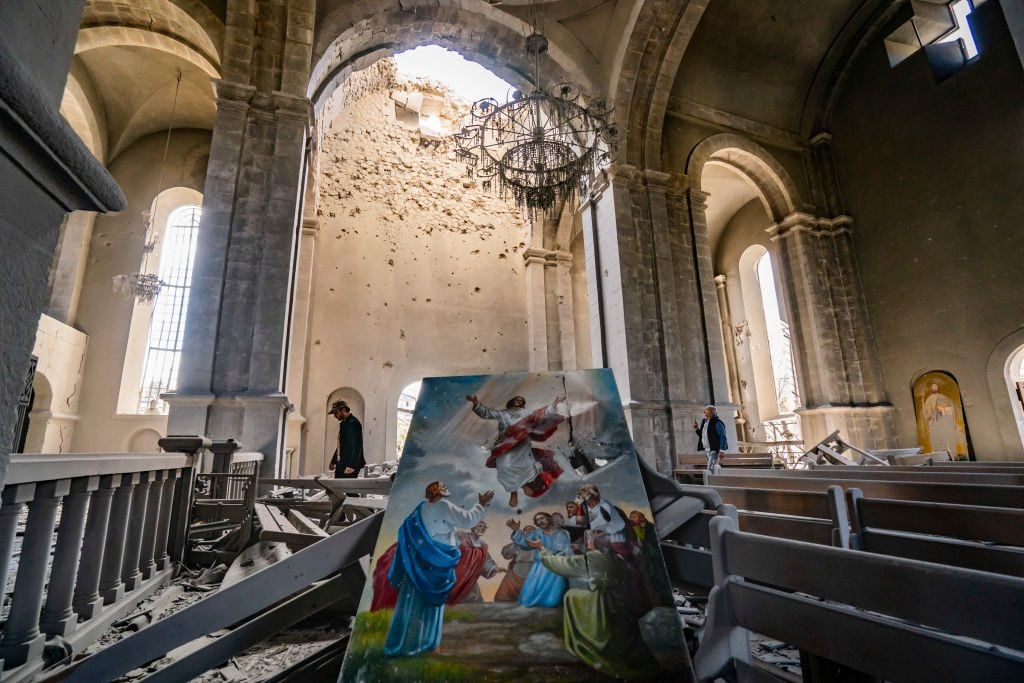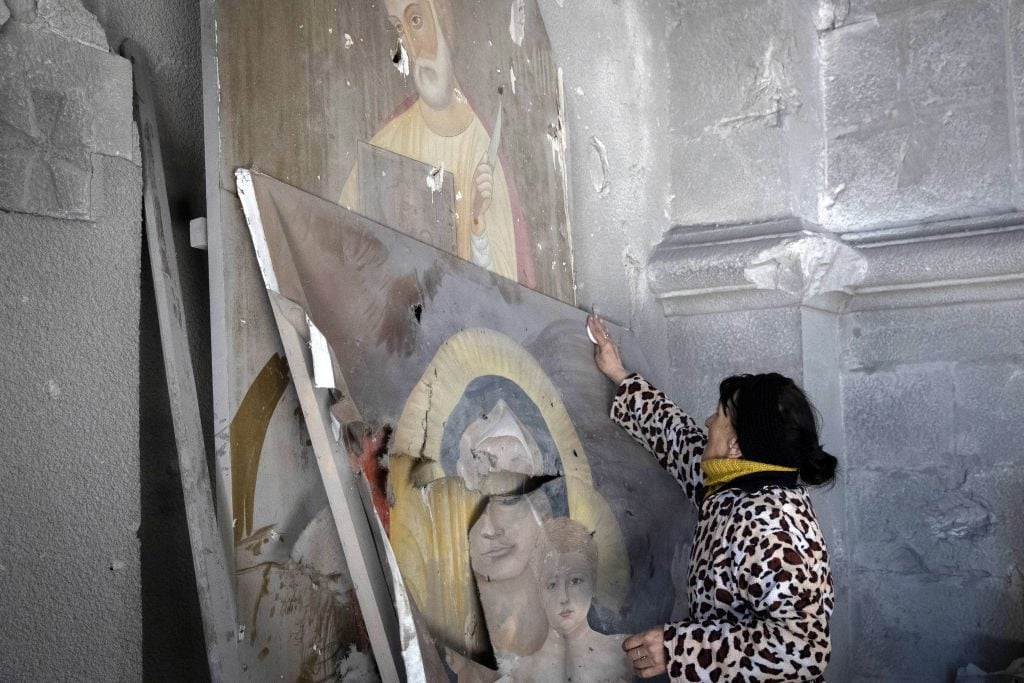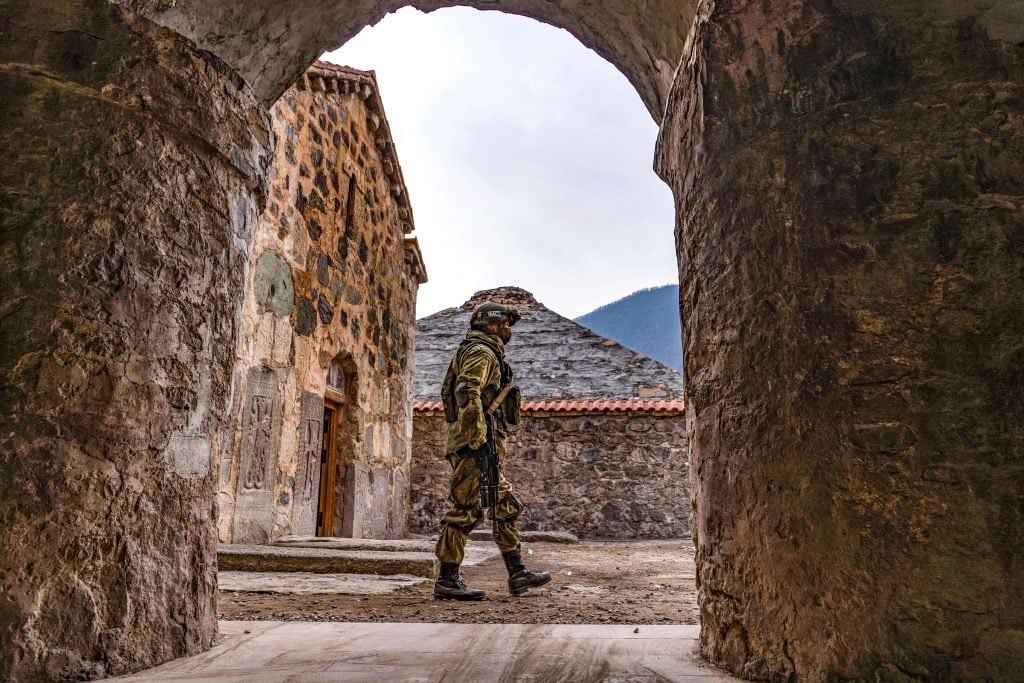Politics
As War Between Armenia and Azerbaijan Is Averted, Artists There Look to the Future. But Much of Their Cultural Past Has Been Destroyed
The path to renewal and peace will be long. Can art and culture play a role?

The path to renewal and peace will be long. Can art and culture play a role?

Kate Brown

“I don’t know which day of war it is today… I stopped counting,” Anna Kamay, an independent curator living in Yerevan, Armenia, told Artnet News in an email. “This nightmare has to end immediately.“
For the time being, it seems that a bloody and divisive conflict over the disputed region of Nagorno-Karabak has come to a tentative end. A ceasefire deal was declared last Monday—the fourth since the war broke out between Armenia and Azerbaijan in September.
Over this past weekend, Armenians packed up and some burned their houses in Artsakh, what they call the Nagorno-Karabak region, before leaving lands they had lived on for a quarter of a century. Azerbaijan managed to reclaim the area, which is rich with ancient monuments, and as it returns to the ceded territory. Yet many fear that key sites of Armenian cultural history, some hundreds of years old, will be lost forever.

A local resident wipes a religious icon at the Ghazanchetsots Cathedral (Holy Savior Cathedral), partially destroyed in a shelling attack by the Azerbaijani armed forces. Photo: Stanislav KrasilnikovTASS via Getty Images.
At least 1,000 people have died since the fighting began, though some officials say the true death toll could number as many as 5,000. Active war broke out when Azerbaijan decided to retrieve 13 percent of its land within the disputed Nagorno-Karabakh region, though the conflict has ebbed and flowed since the 1980s. After nearly six weeks of fighting, Russian peacekeeping troops were deployed to the area.
“The losses on both sides are difficult to even comprehend. We are all in mourning. These are young men who are dying, the future of both of these countries,” says Azeri curator Suad Garayeva. “Yet the plight of more than 800,000 Azerbaijani refugees, who were expelled from Karabakh and unable to return to these lands for almost 30 years, is impossible to overlook.”
In the ceasefire deal brokered this week, Azerbaijan regained control of the city of Shusha, which is steeped with cultural significance to both countries. Azeris had lost the city and the region around it during a brutal 1990s war, and it was a strategic marker in the conflict that broke out this fall.
“Shusha has always been the heart of Azerbaijani culture,” says Faig Ahmed, an artist living and working in Baku, Azerbaijan. He says he has already begun planning an art exhibition in Shusha.
Shusha is of important cultural and historic significance to Armenians as well, and many are calling for their Prime Minister, Nikol Pashinyan, to step down for signing the agreement that turned it over to Azerbaijan.
Cultural heritage from both sides has often been caught in the cross-fire and some are now concerned about the future of the heritage in the ceded territory.
During this month’s conflict, a key piece of Armenian heritage, the Ghazanchetsots Holy Saviour Cathedral, was hit by what appears to be an Azeri offensive. Many are worried that, even after the ceasefire, more sites of cultural heritage remain under threat. During the past decade, Azerbaijan destroyed 89 Armenian churches, 5,840 intricately carved cross-stones called khachkars, and 22,000 tombstones in the Azeri region of Nakhichevan, according to a 2019 report in Hyperallergic.
Azerbaijan’s ministry of culture has pledged to preserve mosques and other Islamic monuments in the region. “The Christian heritage, irrespective of its origin will also be preserved, restored and put into operation at the highest level,” the ministry said in a statement, adding that the destruction of several historic Azeri sites has also taken place.
“The end to active combat in the 2020 Nagorno-Karabakh war is far from the end of the war on a key victim: the rich and irreplaceable cultural heritage of Artsakh,” read a statement from the Armenian General Benevolent Union that was signed by numerous scholars. “[T]he world looks away as Armenian art, architecture, and history are being destroyed.”
On Friday, the Azeri deputy minister for culture tweeted that a historic church in the region, the Khudavang monastery, also known as the Dadivank monastery, was built in the 9th to 13th century by Albanian royalty. Armenian academics refute this claim in their statement, referring to “an extraordinary set of interior frescoes showing sacred and historical figures and Armenian inscriptions” dating back to the 13th century. “While recent restoration efforts by an Italian team have sought to stabilize its deteriorated state, their work is now under imminent threat of reversal,” they wrote. On Friday, Armenians held a final religious service at the monastery.
International bodies are urging both sides to avoid incurring further damage to cultural heritage, regardless of who it belongs to. “UNESCO expresses its grave concern with the continuing escalation of violence in the Nagorno-Karabakh conflict zone, which is causing rising civilian casualties and inflicting damage on civilian infrastructure, including schools, cultural and religious sites, and also affecting the safety of journalists,” read a statement from the organization in September.

A Russian peacekeeper walks past along a yard of the 12th-13th century Dadivank Monastery, outside the town of Kalbajar on November 16, 2020, after the monastery was put under their protection as part of the peace agreement putting an end to the military conflict between Armenia and Azerbaijan over the breakaway region of Nagorno-Karabakh. Photo: Andrey Borodulin/AFP via Getty Images.
Some artists from the region say they are using their work as a source of healing and a path through the trauma, while others feel that the fighting has made creativity feel impossible.
Babi Badalov, an Azerbaijani artist based in Paris, says that watching the conflict has been devastating for his “artistic soul.” He says that the broader cultural community outside of the region is biased and largely ignorant to the nature of this conflict. He has been focusing on his installation Culture is Future, which imagines a fresh start without cultural pasts and racial tensions, in a borderless world. “It imagines how we could create a common human heritage on Earth,” he tells Artnet News.
Anush Zeinalian, an art manager based between the Armenian capital of Yerevan and Venice, Italy, volunteered on the front lines at the beginning of the conflict. Now, it is difficult to develop art projects in Armenia, she said, given the national state of mourning. “I have passed through many stages of trying to identify my own personal strategy in this time of war,” she said. “After some time, I was able to bring myself back from that apathy and concentrate on a project with artists that I had committed to before.”
Artists have also been raising funds through efforts like the print benefit Photographes pour la paix, which was started by Paris-based Armenian Rebecca Topakian. “It has been really hard to be far from my people while they experience such tragedy,” she told Artnet News. She created the print sale to raise money for humanitarian aid in Artsakh. “Maybe one day, when war is over, artistic and cultural initiatives will help… Peace is definitely a creative work.”
Though it may still be far off, art could be a forum for thawing tensions. Azerbaijani artist Sitara Ibrahimbayli hopes that communication could begin again between Armenian and Azerbaijani artists. “I think that the most important thing is, first of all, the study of each other’s history and culture, based on independent sources,” she said. “Only after hatred is replaced in the consciousness by curiosity, everything will become much easier and more humane.”
Sereg Navasardyan, an artist in Yerevan, says that art has been a way to communicate his experiences of the war. “We and our neighbors have a lot of cultural commonalities. Art is a very important medium to talk about problems, to share thoughts and worries that are universal,” he said.
Navasardyan points out that there are important cultural commonalities between Armenians and Azerbaijanis. “Because we have lived side by side for so long, we have shared almost every aspect of our societies. But the border conflict has brought up a battle not only over land, but differing cultural ‘values,'” he said. “I hope that at some point we will realize that there is no ‘mine’ and there is no ‘theirs,’ but there is ‘ours’ instead. This can be the key to understanding and resolving a conflict.”
“At the same time, there is a great need for new ideas and projects—the war will end one day, and we should start constructing our post-war reality today,” Navasardyan says. “I believe art is of great help.”
[November 17 9:00 p.m. CET: This article was updated to include a statement from the Azeri Ministry of Culture.]
[November 18 9:00 a.m CET: An earlier version of this article stated that Armenian cultural sites are thousands of years old. It is more accurate to say hundreds of years old.]